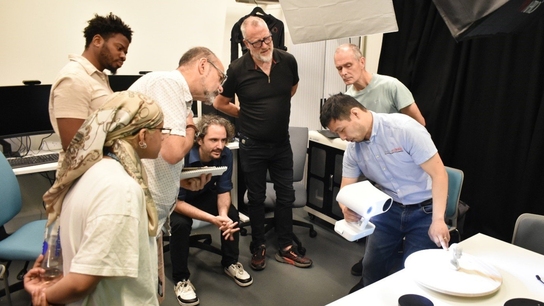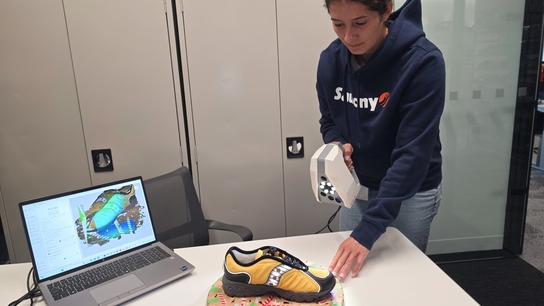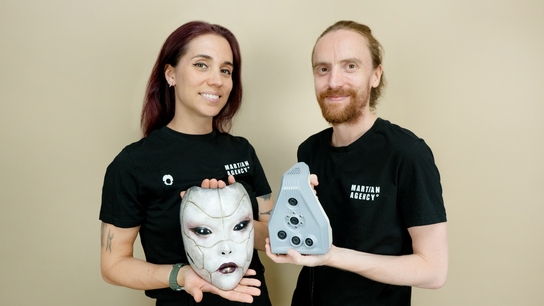Artec 3D scanning sheds light on England’s barbaric forgotten sport
Challenge: Digitizing a 400-year-old bone with such precision that a lifelike copy could be reproduced and shared to teach the public about a brutal early modern English sport.
Solution: Artec Space Spider, Artec Micro, Artec Studio
Result: True-to-life 3D-printed bear bone models, shown to museum visitors so they can see bear bone size and injuries in-person. These also immortalize how a sample initially looked before undergoing destructive analysis.
Why Artec 3D?: With Artec 3D scanning, the bone could be precisely captured without constant handling. This protected it from damage and allowed it to be measured and 3D modeled far more quickly than would’ve been the case with calipers or photogrammetry.

University of Nottingham students learning to digitize artifacts with Artec Space Spider. Photo courtesy of the University of Nottingham
In movies, they tend to be typecast as predators with a penchant for attacking those lost in the woods, but in reality, it’s bears that are often mistreated by humans. They continue to be kept in captivity and subjected to cruel practices like bile extraction, and believe it or not, when baiting was around, they used to suffer even worse.
By the 16th century, what began as a custom where bulls had to fight dogs or be ‘baited’ before their hides could be sold, had evolved into a popular form of entertainment.
From what we know, baiting involved bulls (or later bears) being tied to stakes, before dogs were set on them, with crowds betting on who’d win. In Shakespeare’s London, you may not think it was that prominent. On the contrary, baiting was often seen next to playhouses, and it gained such popularity, it even had a royally appointed ‘Master’ of the competing animals.

A cartoon depicting bear baiting in the nineteenth century. Image courtesy of Wikimedia Commons
With many Brits oblivious to baiting, there remains a need to educate new generations on the country’s brutal past, a lesson being taught by Box Office Bears with the help of Artec Space Spider and Artec Micro.
Box Office Bears
Aiming to uncover and share the stories of the animals behind England’s bear baiting history, researchers at the universities of Nottingham, Oxford, and Roehampton have joined forces with the Museum of London Archeology (MOLA) to set up Box Office Bears.
The initiative is designed to bring together discoveries including bones, building remains, maps, and diary entries to better understand the sport and why it was so unsettlingly popular. However, in order for bone samples to be scientifically analyzed, they need to be drilled into, in a way that inevitably causes damage but also uncovers vital new information.
Having raised significant Arts and Humanities Research Council (AHRC) funding, the team have now found a way to digitally preserve finds first. Working with Gold-certified Artec partner Patrick Thorn and Co., they’ve acquired and got to grips with Artec Micro and Artec Space Spider, two proven game-changers in the field of heritage conservation.
Digitizing a 400-year-old tibia
Principal investigator Hannah O’Regan was able to get her first sample scanned before these devices even arrived, using a Space Spider at the University of Nottingham Medical School.
Assistant professor associate Natasha Noel-Barker stepped up to do the scanning and found accurately digitizing a 400-year-old tibia to be quick and easy. The specimen itself was brown, a color usually difficult to pick up, but with the ultra-precise device she was able to capture details as intricate as tiny pathologies in stunning resolution.

Nottingham’s Natasha Noel-Barker processing Artec Space Spider scans of a 400-year-old bear tibia. Image courtesy of the University of Nottingham
Even curved NURBS surfaces, which O’Regan says “are almost impossible to measure” with tapes or calipers, were captured with incredible accuracy. In fact, Noel-Barker’s initial scans yielded a tibia 3D model so realistic, it has now been 3D printed so visitors to Nottingham’s ‘Bears! Nature, culture, and beyond!’ exhibition can get hands-on with history.
As you’d expect when scientifically analyzing old, delicate remains, the device’s contact-free nature has turned out to be another major benefit of switching to 3D scanning. With O’Regan and her colleagues working to analyze centuries-old specimens, Space Spider has proven perfect for digitizing without damage or contamination.
“For isotope research, radiocarbon dating, and DNA analysis, you have to take a sample and that requires making a hole,” explained O’Regan. “Prior to 3D scanning, we would have taken photographs and measurements. Now we can also 3D scan bones so we’ve got a complete record.”
“With Space Spider, we can digitize and 3D print bones or embed them into websites, so people can maneuver and manipulate samples in-person or on-screen – it’s great!”
Achieving roaring resolution
Nottingham lab technician Susie Sherwin has become central to the digitization efforts of the university’s new N-MESH Labs heritage science initiative, recreating everything from an age-old dice to Viking boots for wider school and museum exhibitions.
With Micro, a desktop 3D scanner boasting jaw-dropping ten-micron accuracy, Sherwin has even been able to scan smaller pieces like coins while capturing their tiny intricacies. In terms of the device’s USP, she sees this as its ability to “cover all the angles,” and says “as long as you remember to turn objects over, you know Micro will pick everything up.”
Elsewhere, Sherwin has contributed to bear research too, digitizing a skull from Buxton Museum and Art Gallery. As well as its precise capture capabilities, Space Spider’s easy-to-handle form factor and portability, were critical to the specimen being rapidly and accurately replicated for display at the Nottingham University Museum of Archeology.
3D scan capture and processing software Artec Studio was also key to achieving this. After a few pointers from Patrick Thorn, Sherwin found the platform’s auto-alignment algorithm ideal for overlaying scans to get complete results. On the flipside, when digitizing a vase, manual alignment later proved more effective, showcasing the program’s immense flexibility.
In the months ahead, Sherwin plans to begin using another advanced Artec Studio feature: photogrammetry import. Combining this data with high-resolution 3D scanning allows for the creation of meshes with true-to-life textures and even more accurate geometries.
With Nottingham students having already experimented with the technology, she anticipates this will quickly help improve the quality of the models the university is able to share.
“In the network, we have this digital lab where undergraduates can scan ancient documents and other museum items,” explained Sherwin. “Previously they used photogrammetry, this year we’re adding 3D scanning and merging the two, so we can achieve better quality.”
“Photogrammetry [alone] doesn’t necessarily pick up all the things you want. But 3D scanning is lovely to use – the way you can turn 360 degrees around an object and zoom in – you capture so many more details.”
Uncovering ancient secrets
With Artec 3D scanning, the University of Nottingham team hasn’t just begun sharing finds, it has integrated the technology into its workflow to advance its wider research goals.
“It’s an exciting thing to do and there’s a lot of potential in terms of our workflow,” added O’Regan. “Now, we can get any bone we want to sample, X-ray and 3D scan it. This way we can get a really good picture of the entire specimen, before we go anywhere near it with a drill. That’s really, really valuable from our point of view.”

Box Office Bears team members Dr Andy Kesson, Prof Hannah O’Regan and Dr Liam Lewis posing with a bear cut-out. Image courtesy of the University of Nottingham
Moving forward, the department’s library of digital relics is only set to grow, as students get to grips with the N-MESH Lab’s growing arsenal of technical tools. Whether it be via 3D scanning, photogrammetry, mesh-polishing software, or a combination of all three, it’s hoped this lifelike online treasure trove will bring British heritage research to new audiences.
Visitors were able to see the original bear tibia and cranium at the Nottingham University Museum of Archeology’s ‘Bears! Nature, culture, and beyond!’ exhibition which ran until Dec. 31, 2023.
Nottingham University’s current selection of 3D scanned archaeological models can be accessed via Sketchfab here.
Scanners behind the story
Try out the world's leading handheld 3D scanners.






